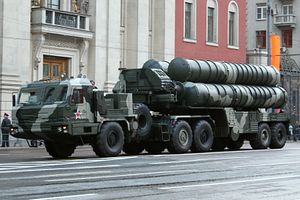The Chinese People’s Liberation Army (PLA) officially took ownership of the first regimental set of Russian-made S-400 Triumf advanced interceptor-based air defense systems (NATO reporting name: SA-21 Growler) last week, according to Russian media reports.
“Last week, an acceptance certificate was signed for the first batch of S-400 systems that was delivered from Russia by sea in May 2018. The systems passed over to China’s ownership once the documents was signed,” a Russian source is quoted by TASS news agency as saying earlier this week.
The first two Russian cargo ships carrying the bulk of the S-400 equipment, including launchers and mobile radar systems, arrived in China in April. The last delivery reportedly took place in early May. Russian personnel has been handing over the equipment to the Chinese military over the past months, a process which apparently has now been completed.
Russia’s Federal Service for Military Technical Cooperation has neither confirmed the delivery, nor the transfer of the first S-400 regimental set to the PLA. China has reportedly ordered two S-400 regiments for an estimated $3 billion. The second regimental set is expected to be delivered in the coming months. It remains unclear when the first S-400 unit will enter service with the PLA. As I explained earlier this month:
A S-400 regiment is divided up into two battalions (also called divisions in the Russian military), which in turn are split into two batteries. A battery can consist of up to 12 transporter erector launchers (TELs), although 4 to 8 TELs per unit are more common. In addition to the TELs, each battery includes a target acquisition and engagement (fire control) radar systems and a command post, as well as an additional fire control radar system.
A road-mobile S-400 battery can deploy within five to ten minutes and engage up to 36 targets simultaneously.
It is not known what missiles China has ordered from Russia. According to some reports, the first regimental unit delivered to China will be armed with the 48N6E2, next to other missiles, whereas the second regiment might receive the 40N6E, the export variant of the 40N6. The 40N6 is the S-400’s most advanced missile interceptor and is expected to be inducted into service with the Russian military this month or next.
The 40N6 missile has an estimated operational range of 400 kilometers (248.5 miles) and can reach a maximum altitude of up to 185 kilometers (607,000 feet). The 40N6 is assumed to be capable of exo-atmospheric interception of intermediate-range ballistic missile warheads in their terminal phase. I described the S-400s other missile systems elsewhere:
In comparison to its predecessor, the S-300, the S-400 air defense system features an improved radar system and updated software; it can purportedly fire four new types of surface-to-air (SAM) missiles in addition to the S-300’s 48N6E, a vertical tube launched, solid fuel, single stage SAM with an estimated range of 150 kilometers (93 miles), and the improved 48N6E2 missile with a reported range of 195 kilometers (121 miles).
(…)
The S-400 is also armed with an improved variant of the 48N6E2 with an alleged range of 250 kilometers (160 miles). The air defense system can also fire two additional missiles, the 9M96E and 9M96E2 with respective ranges of 40 km (25 miles) and 120 km (75 miles). Improved S-300 air defense systems such as the S-300PMU-2 Favorite … can purportedly also fire the 9M96E and 9M96E2.
The Russian military accepted into service its first S-400 regiment of the year earlier this week, bringing the total number of deployed S-400 regiments in the Russian military to 24, according to a Diplomat estimate. By 2020, this number is expected to grow to 28 regimens or 56 battalions.































